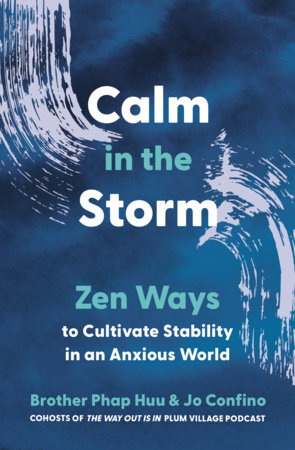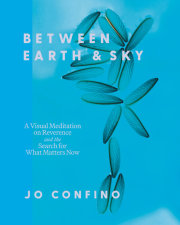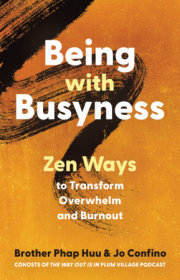Your true home is not an abstract idea; it is something you can touch and live in every moment. No one can take it away from you. Other people can occupy your country, they can even put you in prison, but they cannot take away your true home and your freedom.
—Zen Master Thich Nhat Hanh
Preface: Arriving
Welcome, dear friends, to this guide to coming home to ourselves and coming home to life. Many of us have traveled a long distance from our center, the place where we can accept ourselves as we are and feel stability in an often chaotic world. We live in an age of anxiety; our nervous systems are overloaded.
Many of us juggle complex lives and face pressures to do more and be more. Navigating our own lives is difficult enough, but we do so in the context of a world in turmoil. Exponential changes in technology alongside the fraying of political consensus and institutions that have for many decades helped to create social cohesion are challenging our stability and trust. As if this were not enough, we face threats of runaway climate change, eco-system degradation, and increasing social injustice. This heavy emotional load generates grief and despair—the possible collapse of civilization as we know it has entered our consciousness and the mainstream dialogue.
In these times when everything appears to be in turmoil and we can feel powerless to shape our world, it is important to cultivate calm in the storm. When we are stable in our center, we can develop the capacity and resilience to accompany ourselves and others through these difficult and momentous times. We can
respond rather than
react or burn out.
This requires taking time to reflect, a habit that is in stark contrast to our current culture of striving, our expectation for constant progress, and a belief that time is money. When we’re always looking forward, we sometimes forget to slow down long enough to pay attention to the streams of wisdom passed down to us through many generations that are still as fresh and relevant today as when they first emerged into our collective consciousness.
We have both found great treasures in the 2,600-year-old teachings of the Buddha, which offer valuable pathways to help us face the polycrisis—the convergence of multiple, interconnected crises that amplify each other—with stability and presence. We are grateful for the simple and profound way these teachings have been embodied and transmitted to us by Zen Master Thich Nhat Hanh, our teacher, who is known as “Thay” (an affectionate Vietnamese term for teacher). Thay would
have said: “There is no path to being calm, calmness is the path. There is no way to stability, stability is the way.”
The title of this book is inspired by one of Thay’s teachings in which he uses the metaphor of a boat battered by a big storm and in danger of sinking. The passengers and crew on this boat are fearful, and they’re frantically running from one side of the deck to the other. If everyone panics like this, Thay points out, the ship will surely be lost. If even one person is able to remain calm, however, their stability might be transmitted to others, and then there is a chance the crew of this sinking ship will be able to work together to save the vessel and their own lives.
To start benefiting from Zen practices involves no complexity or esoteric knowledge, nor years of formal training. All that is needed to get going is to take the first mindful breath and then to keep breathing with awareness, to take the first mindful step and then to keep walking. Cultivating calm in the storm is neither a sprint nor a marathon. We can deepen our understanding until our very last breath and share the wisdom we accumulate along the way with others, who can then further develop their own insights and share them in turn with their family, friends, and community. There is no beginning and no end to this path of peace and freedom; we are drops in the eternal river of life.
Our wish in writing this book is to share what we have learned about cultivating calm in the storm with the hope of offering you spiritual sustenance and practical encouragement as you walk your own path. Many people question what it takes to remain hopeful in these difficult times. In this book, we focus our attention on the understanding that while we cannot change the world on our own, we do have the capacity to change ourselves. Tending to our overwhelm or anxiety offers the greatest opportunity to find our own stability; from this place of centeredness, we can reach out into the world and act with fierce, rooted compassion. It takes visceral knowing, not intellectual understanding, to bring about fundamental change. If we want to see greater kindness in the world, we need to find our own tenderness within. If we want the world to move away from polarization to deeper collaboration, we ourselves need to find ways to listen deeply to those we believe to be the cause of our suffering. If we want others to feel less isolated and lonely, we need
to see past our own beliefs about our separation and disconnection.
The wisdom of the Buddha, the essential insight at the heart of this path, is to accept and engage with our suffering rather than think we can go around it. Suffering and peace belong to each other: we must touch our suffering to touch our peace, and once we touch our peace, we are capable of touching our suffering. If we know how to suffer, we suffer less. The foundational power of this
truth—the way out is in—is what inspired us to choose it for the title of the podcast we co-host.
The core teaching of the Buddha is the Four Noble Truths. The first truth is to acknowledge the presence of suffering, and the second is to recognize the causes of suffering. Fortunately, the Buddha identified the third and fourth Noble Truths: suffering can be transformed, and there is a path that leads to the cessation of suffering.
People often fall into two disparate camps: eternally optimistic about the future and repressing the difficult circumstances we face, or struck down by a sense of disenchantment and grief. We have benefited from taking the middle path, which is rooted in honesty and deep looking. From this place of calmness, contemplation, and acknowledgment of what is, we can look our challenges directly in the eye, without averting our gaze, and remain steady. From this place of stability, we can see how we want to respond to the difficulties in our own lives and in the world around us. The middle path, the path of stability these pages explore, reminds us that even if we are facing emotional turmoil, we can still enjoy the beauty of a flower blossoming or the smile of a stranger. We have the capacity to hold much more than one feeling. If we can see our suffering and understand it, transformation is possible.
The formidable American poet W. S. Merwin takes this to its ultimate conclusion in his poem “Place”; “On the last day of the world/I would want to plant a tree” he says. “I want the tree that stands/in the earth for the first time/with the sun already/going down....” Even if we face the unimaginable grief of knowing the world will end today, we can still touch the essence of love and life.
Alone, Together: Our SufferingFirst, the suffering. Western society has encouraged and finessed a perverse, vice-like trap: we are caught between the jaws of a desire to be perfect and feelings of self-loathing. A lose-lose situation. Though many of us do not believe we are good enough, paradoxically we constantly seek to prove that we are. The more we struggle, the more this trap can tighten its grip on us.
Beyond this alienation from ourselves and our inherent worth, we also experience alienation from each other and from Mother Earth. Human relationships have increasingly become transactional, based on competition and a sense of scarcity. Our busyness and experience of overwhelm or even anxiety make it harder to find the time to develop closer friendships. In an age of technologically infused ultra-connectivity, growing numbers of people feel lonely and disconnected from intimacy and love—from each other and from our environment. Rather than feeling a reverence for the natural world, our minds have been corrupted by the feverish demands of a capitalist system that encourages us to see the planet as a mere inanimate resource to be exploited and consumed. The majority of the world’s population now live in cities, and many do not have the opportunity to experience nature. Of course, nature is everywhere: even a cell phone contains natural materials taken from the earth, and there is immense value in appreciating the wildness of a dandelion pushing up through a crack in the sidewalk. Yet nature here refers to landscapes not extensively developed by humans, to the unique and increasingly rare experience of moving through a place not defined by humans, places where a larger-than-human perspective looks you in the eyes. We are not comfortable in ourselves, we are not comfortable with each other, and we are not comfortable on our planet. This experience of being untethered from an innate sense of belonging can generate a toxic cocktail of emotions, ranging from helplessness and hopelessness to betrayal and anger. In this agitated state, we seek to create a sense of calm by trying to take back control and protect our self-esteem. We are like wanderers who feel we do not belong, and we therefore often buy into the idea that a particular product, experience, or lifestyle will allow us to be ourselves and feel part of this world.
The Storm Is RagingWhile we know the facts and figures, it is worth deeplyconnecting to the simple fact that human civilization has Calm in the Storm xvi been changing at an extraordinary and unrelenting pace since the industrial revolution only 260 years ago. Just compare this with the relatively slow speed of human development over the previous 600,000 years. Before the industrial revolution began in the 1760s, most people stayed close to the place they were born for their entire lives. Their days were largely spent within their extended families and the local community; most people lived close to the land, their days carved out by the changing seasons. Faith and religion gave a greater sense of meaning and direction. The economy was largely local—most people had few material goods and few ambitions. News traveled slowly, and there was little knowledge of what was going on in the outside world. Life was slower and simpler. It is important not to see the past through rose- tinted glasses: life then was extremely limited and there was immense suffering related to short life expectancy, extreme poverty, and a lack of freedom of movement or expression. Life in the modern era is in many ways far better—more people, particularly in the West, enjoy longer life expectancy, a higher standard of living, and greater freedom. But we pay a considerable emotional and spiritual cost; we have veered perilously to the other extreme and our pursuit of comfort and freedom generates pain and destruction for other people and other species. Preface xvii It is an especially difficult time to be young. Many teenagers, particularly in the West, are experiencing whiplash from the relentless demands to fit particular ways of looking or behaving. Flooded by images and videos of people experiencing so-called perfect moments, it is hard not to feel one’s own life is imperfect at best.
Fear of being judged or even canceled on social media for placing one word or one foot out of place can mean being in a near-constant state of high alert. Stopping and resting have become luxuries many people feel are often beyond their grasp. We are no longer in tune with the changes of seasons: we are expected to be just as productive in the winter as in the spring. Just imagine if the rest of nature had to operate in this way!
It is exhausting and unsustainable. Even if we are able to slow down and stop, we often feel guilty or our minds start clamoring for action. Quietness is often equated with boredom. Annual holidays tend to be about recuperation rather than relaxation, and we see many examples of people getting ill as soon as they go on vacation because their bodies and minds have been so stressed. Rather than savoring our successes, we move immediately to the next thing on our to-do list. We see this across the corporate world, where teams complain there is no time to celebrate one goal being achieved before the next challenge lands on their plates
This already fast pace of change continues to quicken. Technological advancements, such as AI, are exponential in nature. The flood of fake news and images is making it increasingly difficult to discern what is real and what we can trust. We are outsourcing our knowledge and understanding of the world to ChatGPT and Google. While we may be becoming cleverer, wisdom lags far behind. Social cohesion is fraying and, in some cases, has unraveled. We often do not know our neighbors, never mind the place our ancestors came from. In our wish to be independent, we often experience less contact with our families and communities. With the diminishment of traditional religion, many people are no longer grounded by a spiritual practice. The free market and consumerism have rushed in to fill this void, and the vacuum has created an extremely narrow view of success and happiness by which we value and judge ourselves and others. The broader context of our essential humanity often ends up on the cutting room floor. We are witnessing the emergence of an existential crisis. Even a decade ago, climate change for many felt like an abstract idea that was merely to be understood intellectually via facts and figures. But now the impacts of extreme weather have reached our doorsteps. We see daily the impacts of fires, flooding, and droughts, and we know there is potentially far worse to come. The ecosystems on which our lives and wellbeing depend are degrading mercilessly—in just the last fifty years alone, there has been a catastrophic 73 percent decline in the average size of monitored wildlife populations.
The Gift of DeathOur dread of civilizational collapse is forcing us, whether we know it or not, to touch our own mortality. Many (if not most) of us wish to avoid the fact that we will one day die. Our various responses to the polycrisis can, in part, be explained by the insights social anthropologist Ernest Becker shared in his 1970s Pulitzer Prize–winning book,
The Denial of Death. Becker’s work inspired the development of terror management theory, which explores how we tend to respond to threats to our established way of seeing the world (including threats to our own denial of death) by belittling those with different views, seeking to convert our perceived opponents to our own belief system, or responding with physical violence to annihilate our enemies. As we increasingly seek refuge in our own echo chambers, there are profound repercussions for the political sphere: we are experiencing increased polarization.
Buddhist teachings offer an alternative path, helping us to understand there is no need to fear our mortality. We can understand that we are part of a stream of life stretching back to the beginning of time and into the infinite future. We are each one drop in the eternal river of life. Joanna Macy, a longtime environmental activist, Buddhist scholar, and deep ecologist, speaks eloquently to the possibility of death even being a gift: “Death walks with us, and that is the great mystery,” she said as a guest on our podcast. “I love the way it’s put in the writings of the Dharma: death is certain, but the time of death is uncertain. It’s a double whammy. You are going to die and you don’t know when. It could be in five minutes or fifty years. This keeps us kind of on an edge of presence.
We are on borrowed time, and this gives us a quality of being able to be present and in the now—because it’s all we know we have. It’s really all we have.”
Rather than seeing those with opposing views as our enemies, we have the option of looking through the lens of interbeing. When we do this, we see that we are not individual separate selves; at the core, all our lives are deeply intertwined. On a fundamental level, we all want to transform our suffering, but the way we each seek to do this is determined by numerous different causes and conditions: our ancestral patterns, our parenting, our environment, our society, and our own lived experience. Our individual beliefs and perceptions about the world and how we want it to be all come from the same source: a desire to experience ease and well-being.
Copyright © 2025 by Jo Confino and Brother Phap Huu. All rights reserved. No part of this excerpt may be reproduced or reprinted without permission in writing from the publisher.









